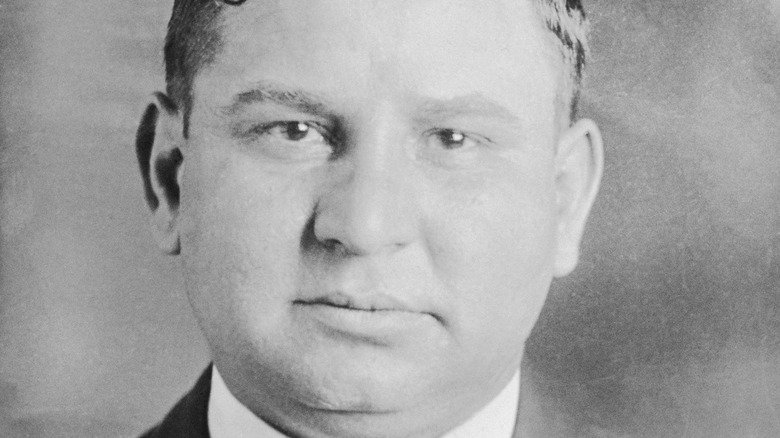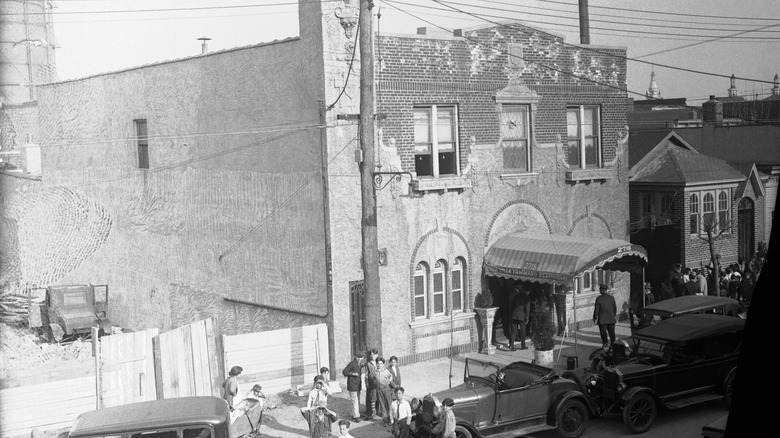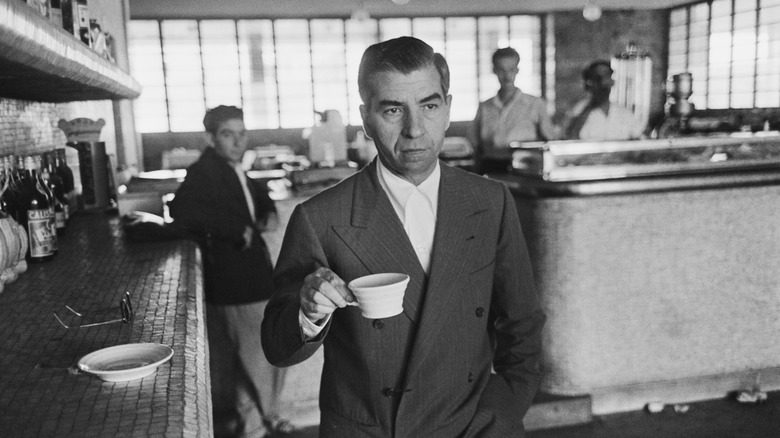The Bloody Crime Scene Of Mobster Joe Masseria's Murder
It is one of the most famous images of the 1930s mob wars: the bloodied hand of a dead man who lies dead on blood-stained floorboards, a napkin or perhaps a tablecloth covering his torso but not his face, which is thankfully blurred from view. In the hand, angled as though placed between the lifeless fingers like a calling card from the man's assassin, is a card: the ace of spades.
Cinematic, but the fact is that the image is real, and the story of the man it depicts has fascinated true crime enthusiasts and inspired writers and filmmakers for nearly a century. The body is that of Giuseppe "Joe" Masseria, who had emigrated from Sicily to America while still a teenager just after the turn of the century. In New York, he had become active in the Italian gang scene, specializing in racketeering, extortion, and bootlegging as what became known as the Five Families vied for money and power. Masseria became known as "Joe the Boss" in 1922, when he became the head of the Westside crime family. According to a New York Times source, at the height of his power and influence, he was considered "bigger than Al Capone." But Masseria's reign lasted nine years before he was gunned down in a Coney Island restaurant.
Varying reports
As with many legends, the details of Joe Masseria's murder have become blurry over the nine decades since his death, with varying accounts as to the circumstances of his death. The classic 1976 true crime tome "The Last Testament of Lucky Luciano" by Martin A. Gosch and Richard Hammer contains one of the most influential versions of Masseria's downfall. Luciano was a gangster who teamed up with Masseria despite his personal dislike of the capo — the book is said to have been compiled from interviews with Luciano and to offer his true recollections.
In his version, he was with Masseria for lunch in a Coney Island restaurant (pictured) when he was shot. Luciano claims that "Joe the Boss" gorged on four separate dishes and had started on a second bottle of wine before he was ambushed by gunmen who rushed into the restaurant while Luciano was in the bathroom. He claims that he and Masseria had played a single hand of cards before the boss was shot. Other sources, such as John H. Davis' "Mafia Dynasty," describe Masseria as "gluttonous" and also insist he died after a large meal.
Masseria's mugshot shows him as a man who looks unusually stocky for the period in which he lived, which may have led to the myth of his having demolished an enormous meal before he was murdered. However, his autopsy revealed that he had no food in his stomach, which discounts many of the versions of his death that have become part of his legend.
Evidence but no arrests
Multiple sources claim that Giuseppe "Joe" Masseria was shot to death in a hail of around twenty bullets, four or five of which struck him in the back and the head. And just as the details of his last moments have been distorted, the identity of his killers has also been debated. Some say that Lucky Luciano (pictured), his second in command, was responsible. Masseria had gone to war the previous year with another of the Five Families' capos, who it is said cut a deal with Luciano to take Masseria out. This is the version of events presented in "The Last Testament of Lucky Luciano" and indeed, after Masseria was killed, Luciano was installed as the new boss and the war came to an end.
However, it is uncertain whether Luciano was even at the restaurant on the day of the shooting, as his "Last Testament" has been criticized as being partially fabricated. Questions remain about who pulled the trigger. There were few witnesses, and the owner of the restaurant said that he was out for a walk at the time of the shooting, with few staff working. The killers reportedly left their coats at the murder scene, but while one was traced back to a known gangster, investigators were unable to pin the shooting on him. Despite various clues and circumstantial evidence as to who was behind the killing of the notorious Joe the Boss, no one was ever charged with his murder either as a gunman or as one sanctioning the killing.


